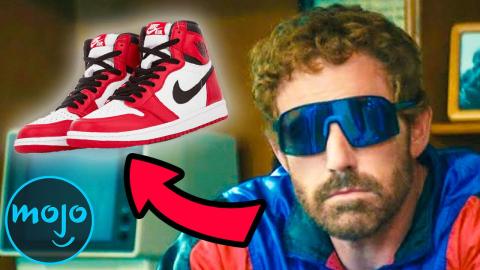The Untold True Story Behind Air Jordans

Blue Ribbon
Top 3 Things You Need to Know About the Super Blue Blood Moon
Without Nike, there would be no Air Jordans, period. Before we can get to MJ rocking fresh kicks on court we need to take it back for a second. Nike was founded as Blue Ribbon Sports back in 1964 by Phil Knight and Bill Bowerman. Bowerman was the longtime track and field coach for the University of Oregon and actually coached Knight when he attended the university. Initially Blue Ribbon was a distributor for Onitsuka Tiger, a Japanese shoe manufacturer. During these early years, Knight would sell the shoes out of the back of his car at track meets. Sales would grow over the next few years the company opened its first retail store in California and would later expand to the east coast. By 1971 the partnership with Onitsuka came to an end as the renamed Nike would introduce its own line of shoes. While doing so, it expanded its product line to include basketball with models like the Blazer and Bruin. George “The Iceman” Gervin was one of the first NBA players to wear the Blazer on court and introduce fans to Nike. At this time the brand was well known for their running shoes and not much else. Basketball footwear was dominated by the likes of Converse and Adidas. That would soon change, however, as a high flying, up and coming player out of North Carolina would soon put a spotlight on the company.
The Rise of Jordan
The Untold Story Of Armie Hammer (House of Hammer)
We’d be surprised if you don’t know who Michael Jordan is but we’ll tell you anyway. He was born February 17, 1963 in New York City. In 1968, his family relocated to Wilmington, North Carolina. There he would play basketball at Emsley A. Laney High School, as well as football and baseball. By the end of high school, Jordan was recruited by several universities and ultimately accepted a basketball scholarship to the University of Carolina at Chapel Hill. During his time at UNC, one of his more notable moments is making the game winning shot during the final of the 1982 NCAA Championship. In 1984 Jordan declared for the 1984 NBA draft where he would ultimately be drafted third overall by the Chicago Bulls. While currently Jordan is cemented as one of the greatest players of the game, at this moment many people didn’t see what the big deal about him was. Sure, he had some success in college but this was the NBA and at a time when it was dominated by centers. And just like the shoes that would soon bear his name, Jordan would change everything.
Light as Air
Quantum Light Explained | The Future Of Physical Matter | Unveiled
Athletes being sponsored by athletic companies is nothing new and upon entering the NBA this was no different for Jordan. His agent, David Falk, had a different vision for his client from what was customary at the time. He wanted MJ to be seen as an individual similar to how tennis and golf players were marketed at the time which differed for basketball players who tended to be part of a brand’s roster of players. You might be thinking that pairing Jordan with Nike was a no brainer but the company was from Jordan’s first choice. Since he played in the 1984 Olympics, the team was outfitted by Adidas and that’s who he wanted to sign with. Unfortunately for them, they were going through major financial troubles and there was no way they could do a deal. Falk and Jordan also met with Converse who had big name players like Larry Bird and Magic Johnson and made it clear that Jordan, as an unproven rookie, would not be given priority. This left Nike, which was looking to sign a big name that would invigorate the brand. Sonny Vaccaro, a marketing executive at Nike, thought that Jordan could be that player. Still MJ was reluctant to meet with the company and actually was planning on skipping out of the meeting between them and only changed his mind after his mother convinced him to at least hear out the offer. After discussing it with his parents, Jordan signed with Nike, bringing a new line of signature basketball shoes to the market. They would be dubbed the Air Jordan, which was actually coined by Falk and is a name that just works. So now it’s smooth sailing from here on out, right? Well, not exactly.
Banned?
Top 10 American Products That Are BANNED in Other Countries
From the start the Air Jordan was meant to stand out. At the time basketball shoes were predominantly white and to upend this trend Nike decided to have the main color blocking of the shoe be black and red. This caused a bit of a problem in the NBA as, at the time, part of its uniform policy said shoes had to be at least 51% white. In an October 1984 preseason game against the New York Knicks, Jordan wore a black and red shoe, although these weren’t Air Jordans, but a player exclusive version of another Nike shoe called the Air Ship. This caught the attention of the NBA who warned Jordan/Chicago Bulls that this color blocking was in violation of its uniform policy. Nike took this moment and used it to craft a marketing narrative for the Air Jordan claiming that it was banned from the NBA. Apparently Jordan would be fined $5000 every time he wore the banned colors. Now that may be true, in that he could face such a fine, but there’s no documented instance of MJ wearing black and red shoes in any officially sanctioned NBA game. You can find images or video of him wearing them at promotional events, warm ups and during the 1985 Slam Dunk contest but not in an actual NBA game other than that one time in October 1984. Still, whether from the banned marketing by Nike or because Jordan is an insanely great player, when the Air Jordan was released to the public in 1985, it was super successful pulling in $126 million in the first year.
The Legend Continues
The Untold Story of the Crypto King
Even though the shoe was a hit, Jordan wasn’t actually all that happy with them. On an appearance on “Late Night” he went so far as to call the shoes ugly. Even for his next signature release, the Air Jordan II, he wasn’t happy with those either. Remember, he reluctantly signed his deal with Nike. When that contract was set to expire, Jordan was looking to move on from the brand. Other companies were looking to lure him away from Nike. It wasn’t until Nike designer Tinker Hatfield was brought in to design the Air Jordan III that everything changed. When he brought the concept to Jordan and presented the shoe to him, Jordan was convinced to remain with the brand. Jordan’s signature line would continue to be successful as the years went on eventually becoming its own division within Nike. The popularity of the shoes have gone up and down over the years but they have staying power as retros continue to be released alongside newer models. Air Jordans, especially the first model, have become a staple of popular street fashion and will most likely remain as a timeless classic on the feet of many such as Chuck Taylors and Stan Smiths.






